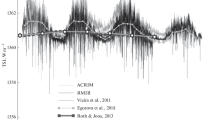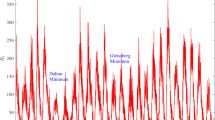Abstract
The chaotic component in solar-activity variations, the limited amount of observational statistics, and the use of proxy data impose limitations on long-term predictions. This study uses the well-known reconstructions of total solar irradiance (TSI) from optical observations (from 1610 AD) and cosmogenic radioisotopes (from 7362 BC) to estimate the maximum Lyapunov exponent for 11-year and secular cycles. This is done with the classical algorithm described by Wolf et al. (1985). The maximum Lyapunov exponents turned out to be positive in both cases, thus confirming the presence of the chaotic component in time series. We then estimate the predictability horizon Tp with the well-known error for each reconstruction. It turned out that the predictability horizon is on average 10 ≤ Tp ≤ 22 years for 11-year cycles and on average 40 ≤ Tp ≤ 60 years for secular cycles.




Similar content being viewed by others
Notes
In other words, the noise in the series becomes dynamic chaos.
REFERENCES
Boffetta, G., Cencini, M., Falcioni, M., and Vulpiani, A., Predictability: A way to characterize complexity, Phys. Rep., 2002, vol. 356, pp. 367–474.
Coddington, O., Lean, J.L., Pilewskie, P., et al., A solar irradiance climate data record, Bull. Am. Meteorol. Soc., 2016, vol. 97, no. 7, pp. 1265–1282. https://www.ncei. noaa.gov/data/solar-spectral-irradiance/access/yearly/.
Dudok de Wit, T., Kopp, G., Fröhlich, C., and Schöll, Methodology to create a new total solar irradiance record: Making a composite out of multiple data records, Geophys. Res. Lett., 2017, vol. 44, no. 3, pp. 1196–1203.
Eckmann, J.-P., Oliffson Kamphorst, S., Ruelle, D., and Ciliberto, S., Lyapunov exponents from time series, Phys. Rev. A, 1986, vol. 34, pp. 4971–4979.
Egorova, T., Schmutz, W., Rozanov, E., et al., Revised historical solar irradiance forcing, Astron. Astrophys., 2018, vol. 615, id A85.
Farmer, J.D. and Sidorovich, J.J., Predicting chaotic time series, Phys. Rev. Lett., 1987, vol. 59, pp. 845–848.
Friedland, G. and Metere, A., Isomorphism between maximum Lyapunov exponent and Shannon’s channel capacity, 2017. https://arxiv.org/abs/1706.08638.
Gott, J.R., Implications of the Copernican principle for our future prospects, Nature, 1993, vol. 363, no. 6427, pp. 315–319.
Hope, A.P., Canty, T.P., Salawitch, R.J., et al., Forecasting global warming, in Paris Climate Agreement: Beacon of Hope, Springer, 2017, pp. 51–113.
Ishkov, B.N. and Shibaev, I.G., Solar activity cycles: General characteristics and modern forecasting boundaries, Bull. Russ. Acad. Sci., 2006, vol. 70, no. 10, pp. 1643–1647.
Kopp, G., Krivova, N., Wu, C.J., and Lean, J., The impact of the revised sunspot record on solar irradiance reconstructions, Sol. Phys., 2016, vol. 291, nos. 9–10, pp. 2951–2965.
Kremliovsky, M.N., Limits of predictability of solar activity, Sol. Phys., 1995, vol. 159, pp. 371–380.
Lean, J.L., Estimating solar irradiance since 850 CE, Earth Space Sci., 2018, vol. 5, no. 4, pp. 133–149.
Letellier, C., Aguirre, L.A., Maquet, J., and Gilmore, R., Evidence for low dimensional chaos in sunspot cycles, Astron. Astrophys., 2006, vol. 449, pp. 379–387.
Makarenko, N.G., Karimova, L.M., Helema, S., and Eronen, M., Evaluating direct and indirect evidence of climatic change by holder regularity and order pattern in time series, Geomagn. Aeron. (Engl. Transl.), 2013, vol. 53, no. 8, pp. 922–926.
McSharry, P.E. and Smith, L.A., Consistent nonlinear dynamics: identifying model Phys. D (Amsterdam, Neth.), 2004, vol. 192, nos. 1–2, pp. 1–22.
Mordvinov, A.V., Skakun, A.A., and Volobuev, D.M., Long-term changes in total solar irradiance and their predictions, Geomagn. Aeron. (Engl. Transl.), 2018, vol. 58, no. 8, pp. 1175–1186.
Moss, D., Kitchatinov, L.L., and Sokoloff, D., Reversals of the solar dipole, Astron. Astrophys., 2013, vol. 550, id L9.
Nagovitsyn, Yu.A., Nagovitsyna, E.Yu., and Makarova, V.V., The Gnevyshev–Ohl rule for physical parameters of the solar magnetic field: The 400-year interval, Astron. Lett., 2009, vol. 35, no. 8, pp. 564–571.
Ott, E., Sauer, T., and Yorke, J.A., Coping with Chaos: Analysis of Chaotic Data and the Exploitation of Chaotic Systems, John Wiley and Sons, 1994.
Pesnell, W.D., Solar cycle predictions (invited review), Sol. Phys., 2012, vol. 281, no. 1, pp. 507–532.
Sano, M. and Sawada, Y., Measurements of the Lyapunov spectrum from a chaotic time series, Phys. Rev. Lett., 1985, vol. 72, no. 13, pp. 1082–1085.
Steinhilber, F. and Beer, J., Prediction of solar activity for the next 500 years, J. Geophys. Res.: Space Phys., 2013, vol. 118, no. 5, pp. 1861–1867.
Steinhilber, F., Beer, J., and Fröhlich, C., Total solar irradiance during the Holocene, Geophys. Res. Lett., 2009, vol. 36, no. 19.
Usoskin, I.G., Comment on the paper by Popova et al. “On a role of quadruple component of magnetic field in defining solar activity in grand cycles”, 2017. https://arxiv.org/ pdf/1710.05203.
Usoskin, I.G., Sokoloff, D., and Moss, D., Grand minima of solar activity and the mean-field dynamo, Sol. Phys., 2009, vol. 254, no. 2, pp. 345–355.
Volobuev, D.M. and Makarenko, N.G., Forecast of the decadal average sunspot number, Sol. Phys., 2008, vol. 249, no. 1, pp. 121–133.
Volobuev, D.M. and Makarenko, N.G., Long-term pulses of dynamic coupling between solar hemispheres, Sol. Phys., 2017, vol. 292, no. 4, id 68.
Wolf, A., Lyapunov exponent estimation from a time series, MATLAB Central File Exchange, 2019. https://www. mathworks.com/matlabcentral/fileexchange/48084-wolf-lyapunov-exponent-estimation-from-a-time-series. Accessed October 27, 2019.
Wolf, A., Swift, J.B., Swinney, H.L., and Vastano, J.A., Determining Lyapunov exponents from a time series, Phys. D (Amsterdam, Neth.), 1985, vol. 16, no. 3, pp. 285–317.
Yeo, K., Krivova, N.A., and Solanki, S.K., EMPIRE: A robust empirical reconstruction of solar irradiance variability, J. Geophys. Res.: Space Phys., 2017, vol. 122, no. 4, pp. 3888–3914.
Zharkova, V.V., Shepherd, S.J., Popova, E., and Zharkov, S.I., Heartbeat of the Sun from Principal Component Analysis and prediction of solar activity on a millenium timescale, Sci. Rep., 2015, vol. 5, id 15 689.
ACKNOWLEDGMENTS
The authors are grateful to an anonymous reviewer for the helpful comments, which allowed us to improve the paper.
Funding
This work was supported by the Ministry of Science of the Republic of Kazakhstan, project no. АР05134227 (Kazakhstan) and by the Russian Foundation for Basic Research, project no. 19-02-00088.
Author information
Authors and Affiliations
Corresponding author
Ethics declarations
The authors state that they have no conflict of interests.
Additional information
Translated by V. Arutyunyan
Rights and permissions
About this article
Cite this article
Volobuev, D.M., Makarenko, N.G. Solar Activity Predictability Horizons. Geomagn. Aeron. 60, 1017–1022 (2020). https://doi.org/10.1134/S0016793220080265
Received:
Revised:
Accepted:
Published:
Issue Date:
DOI: https://doi.org/10.1134/S0016793220080265




